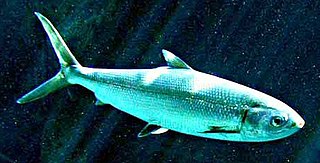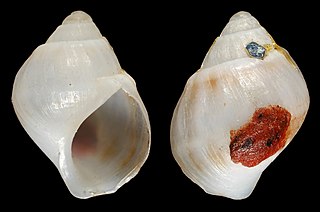
Brackish water, also sometimes termed brack water, is water occurring in a natural environment having more salinity than freshwater, but not as much as seawater. It may result from mixing seawater with fresh water together, as in estuaries, or it may occur in brackish fossil aquifers. The word comes from the Middle Dutch root brak. Certain human activities can produce brackish water, in particular civil engineering projects such as dikes and the flooding of coastal marshland to produce brackish water pools for freshwater shrimp farming. Brackish water is also the primary waste product of the salinity gradient power process. Because brackish water is hostile to the growth of most terrestrial plant species, without appropriate management it is damaging to the environment.

Crayfish are freshwater crustaceans resembling small lobsters. In some locations, they are also known as crawfish, craydids, crawdaddies, crawdads, freshwater lobsters, mountain lobsters, rock lobsters, mudbugs, or yabbies. Taxonomically, they are members of the superfamilies Astacoidea and Parastacoidea. They breathe through feather-like gills. Some species are found in brooks and streams, where fresh water is running, while others thrive in swamps, ditches, and paddy fields. Most crayfish cannot tolerate polluted water, although some species, such as Procambarus clarkii, are hardier. Crayfish feed on animals and plants, either living or decomposing, and detritus.

An ecoregion or ecozone is an ecologically and geographically defined area that is smaller than a bioregion, which in turn is smaller than a biogeographic realm. Ecoregions cover relatively large areas of land or water, and contain characteristic, geographically distinct assemblages of natural communities and species. The biodiversity of flora, fauna and ecosystems that characterise an ecoregion tends to be distinct from that of other ecoregions. In theory, biodiversity or conservation ecoregions are relatively large areas of land or water where the probability of encountering different species and communities at any given point remains relatively constant, within an acceptable range of variation.
Freshwater ecosystems are a subset of Earth's aquatic ecosystems. They include lakes, ponds, rivers, streams, springs, bogs, and wetlands. They can be contrasted with marine ecosystems, which have a larger salt content. Freshwater habitats can be classified by different factors, including temperature, light penetration, nutrients, and vegetation. There are three basic types of freshwater ecosystems: Lentic, lotic and wetlands. Freshwater ecosystems contain 41% of the world's known fish species.

An aquatic ecosystem is an ecosystem in and surrounding a body of water. They are contrasted with terrestrial ecosystems which are those found on land. Communities of organisms that are dependent on each other and on their environment live in aquatic ecosystems. The two main types of aquatic ecosystems are marine ecosystems and freshwater ecosystems. Freshwater ecosystems may be Lentic ; lotic ; and wetlands.

Ostariophysi is the second-largest superorder of fish. Members of this superorder are called ostariophysians. This diverse group contains 10,758 species, about 28% of known fish species in the world and 68% of freshwater species, and are present on all continents except Antarctica. They have a number of common characteristics such as an alarm substance and a Weberian apparatus. Members of this group include fish important to people for food, sport, the aquarium industry, and research.

Macrochelys is a genus of very large freshwater turtles in the family Chelydridae from Southeastern United States. Only a single extant species was recognized until a 2014 study divided it into two, or possibly three species.

Freshwater fish are those that spend some or all of their lives in fresh water, such as rivers and lakes, with a salinity of less than 1.05%. These environments differ from marine conditions in many ways, the most obvious being the difference in levels of salinity. To survive fresh water, the fish need a range of physiological adaptations.

Elseya is a genus of large side-necked turtles, commonly known as Australian snapping turtles, in the family Chelidae. Species in the genus Elseya are found in river systems in northern and northeastern Australia and throughout the river systems of New Guinea. They are identified by the presence of alveolar ridges on the triturating surfaces of the mouth and the presence of a complex bridge strut.

Bridouxia giraudi is a species of tropical freshwater snail with a gill and an operculum, an aquatic gastropod mollusk in the family Paludomidae.

Bridouxia is a genus of small tropical freshwater snails with an operculum, aquatic gastropod mollusks in the family Paludomidae.
Bridouxia ponsonbyi is a species of tropical freshwater snail with a gill and an operculum, an aquatic gastropod mollusc in the family Paludomidae.
Bridouxia praeclara is a species of tropical freshwater snail with a gill and an operculum, aquatic gastropod mollusk in the family Paludomidae.
Bridouxia rotundata is a species of tropical freshwater snail with a gill and an operculum, an aquatic gastropod mollusk in the family Paludomidae.
Bridouxia smithiana is a species of tropical freshwater snail with a gill and an operculum, an aquatic gastropod mollusk in the family Paludomidae.

Paludomidae, common name paludomids, is a family of freshwater snails, gastropod molluscs in the clade Sorbeoconcha.

Freshwater snails are gastropod mollusks which live in fresh water. There are many different families. They are found throughout the world in various habitats, ranging from ephemeral pools to the largest lakes, and from small seeps and springs to major rivers. The great majority of freshwater gastropods have a shell, with very few exceptions. Some groups of snails that live in freshwater respire using gills, whereas other groups need to reach the surface to breathe air. In addition, some are amphibious and have both gills and a lung. Most feed on algae, but many are detritivores and some are filter feeders.

The wildlife of the Philippines includes a significant number of endemic plant and animal species. The country's surrounding waters reportedly have the highest level of marine biodiversity in the world. The Philippines is considered one of the seventeen megadiverse countries as well as global biodiversity hotspot. In the 2000 Red List of the International Union for the Conservation of Nature and Natural Resources (IUCN), 418 of the country's 52,177 species were listed as threatened.

Around 1,300 species of freshwater crabs are distributed throughout the tropics and subtropics, divided among eight families. They show direct development and maternal care of a small number of offspring, in contrast to marine crabs, which release thousands of planktonic larvae. This limits the dispersal abilities of freshwater crabs, so they tend to be endemic to small areas. As a result, a large proportion are threatened with extinction.














